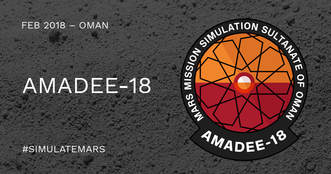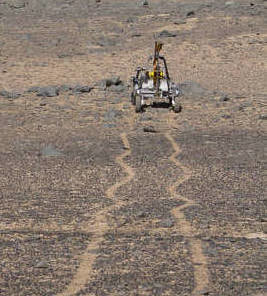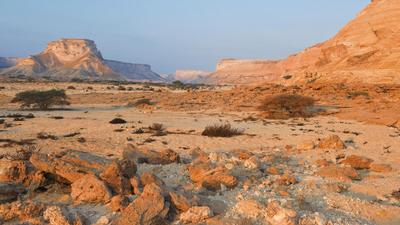|
Manned exploration of Mars is really only a matter of time, and some even say it is a necessity that we step foot on Martian soil. Stephen Hawking declared at a lecture in 2008 "If the human race is to continue for another million years, we will have to boldly go where no one has gone before", while SpaceX entrepreneur Elon Musk confirmed his belief that "Humans need to be a multiplanet species" in an interview with website Slate in 2015. Currently there are two operational and mobile US Mars rovers exploring the surface of the planet, Opportunity landed successfully in 2004 and Curiosity in 2012, so there is already much we know about the surface and landscape of the Red Planet. What awaits any visitors to Mars is a very hostile and harsh environment; its atmosphere is about 100 times thinner than Earth's and is 95% carbon dioxide; temperatures can range from -125°C near the poles in winter to +20°C at midday near the equator; and the surface is covered in a layer of dust containing very fine-grained silicate minerals that tend to stick to surfaces and could be hazardous if breathed in. So the question is how to prepare astronauts for what they are likely to confront on an inhospitable planet that lies at least 55 million kilometres away? "An ounce of practice is worth more than tons of preaching." There is undoubtedly no landscape on Earth that can exactly match the harshness of the Mars conditions, however, we can get close, such as on Mauna Loa volcano, Hawaii where Hi-SEAS analogue missions take place, the Atacama desert in Peru/Chile with its Mars-like arid soils where only the most limited of bacteria can survive, and the Dhofar desert in Oman, where in February 2018 the AMADEE-18 Mars analogue will take place. The use of field research in an environment that mimics Mars conditions in some form is an excellent way of gaining experience, practicing for the 'real thing', but more importantly, understanding the advantages and limitations presented by remote science operations where access to and communications with a central control are subject to difficulties and delays.  AMADEE-18 mission joint project of the Austrian Space Forum & Sultanate of Oman AMADEE-18 mission joint project of the Austrian Space Forum & Sultanate of Oman AMADEE-18 is a simulation mission being conducted by the Austrian Space Forum under the leadership of Forum President Dr. Gernot Grömer, a global partner of InnovaSpace, and in partnership with the Sultanate of Oman. A four-week mission is planned in the Oman desert to serve as an analogue for future manned missions to Mars. This scenario will provide an excellent opportunity for the testing of equipment and procedures in simulated Mars conditions and has the added significance of human involvement, with 6 space-suited 'astronauts' being isolated from the world. Contact with a Mission Control centre in Austria will be possible, but will include a 10-minute signal delay in either direction as per the protocol adopted, although such delays in reality can vary between 4 and 24 minutes each way, depending on the orbit positions of Earth and Mars, and considering the radio signals travelling at the speed of light in the vacuum of space.  Article featured in the Times Newspaper - 4th Sept 2017 Article featured in the Times Newspaper - 4th Sept 2017 The AMADEE-18 analogue is certain to receive much coverage as the mission gets underway, and has already featured in the mainstream media. The team at InnovaSpace will await the results produced by this mission with great interest. Whatever the findings are, the media coverage will undoubtedly attract the interest of the future generations of space explorers, perhaps stimulating and drawing them into the STEAM areas of education. Certainly the Austrian Space Forum has provided encouragement through the addition of an AMADEE-18 Junior Researchers Program, opened to students from Europe and Oman. It is without doubt that Space has a cross-generational and universal appeal, and its beauty lies in it being a truly interdisciplinary area, something that can be used to unite different disciplines. Traditionally, this has often been difficult to achieve within a university context, where individual areas, such as biology, physics, computer science and engineering, follow their own parallel paths. However, learning can undoubtedly be maximised through the use of interdisciplinary teaching and research. The promotion of interdisciplinarity is the core concept of InnovaSpace, with the field of the Space Life Sciences being used as a tool to draw together different subject areas in an interaction that permits new knowledge construction and a deeper understanding of ideas, something that will be vital if Mars analogues are to be translated into the reality of a manned mission to the Red Planet. Blog written by Mary Upritchard Comments are closed.
|
Welcometo the InnovaSpace Knowledge Station Categories
All
|
InnovaSpace Ltd - Registered in England & Wales - No. 11323249
UK Office: 88 Tideslea Path, London, SE280LZ
Privacy Policy I Terms & Conditions
© 2024 InnovaSpace, All Rights Reserved
UK Office: 88 Tideslea Path, London, SE280LZ
Privacy Policy I Terms & Conditions
© 2024 InnovaSpace, All Rights Reserved






 RSS Feed
RSS Feed